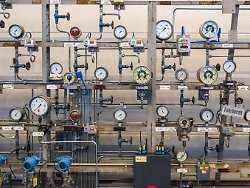Despite gas brakes from Moscow
Storage operator: 90 percent fill level possible
07/27/2022 2:59 p.m
Less gas flows through the Nord Stream 1 pipeline. Nevertheless, the operators of German natural gas storage facilities expect to be able to fill the storage facilities to more than 90 percent. Nevertheless, there is likely to be a shortfall if there is a normal winter.
The German natural gas storage operators assume that gas can continue to be stored despite the renewed reduction in supply volumes from Russia. If LNG imports continue to be high, it is very likely that a filling level of over 90 percent can be reached by November 1st, said Sebastian Bleschke, Managing Director of the Energy Storage Initiative (INES) industry association.
The calculation is based on the assumption that gas transport through the Nord Stream 1 Baltic Sea pipeline will only be at 20 percent of maximum capacity from Wednesday onwards. If this gas were to fall away as well, the situation would have to be further evaluated, said Bleschke. In this context, he pointed out that the gas flows via Nord Stream 1 have already been reduced to such an extent that they are less important when it comes to storage.
“Despite reduced gas flows on Nord Stream 1, a significant amount has been stored in recent days,” he emphasized. On Monday, the German storage was 66.8 percent full, more recent data is not available. The federal government wants to stipulate in a regulation that the German storage tanks must be 95 percent full by November 1st.
The storage facilities compensate for fluctuations in gas consumption and thus form a kind of buffer system for the gas market. They are usually well filled when the heating season begins in autumn. On cold winter days, up to 60 percent of gas consumption in Germany is covered by German storage facilities.
Technology limits storage options
“When the gas storage fill level regulation was presented, it was already clear that an increased filling level target of 95 percent in individual storage facilities could no longer be technically achieved,” Bleschke continued. The technical storage options are now a limiting factor in individual plants. It takes much longer to store gas in pore storage than in cavern storage.
According to Bleschke, even with a filling level of over 90 percent and with gas flows throttled to 20 percent via Nord Stream 1, shortages must be expected in a normal winter. “The system will then only be able to balance itself out by reducing demand.” Politicians should therefore continue to work on reducing demand. “The planned auctions to reduce industrial customer consumption are certainly a very important step.” At the auctions, industrial gas consumers should be able to sell gas they do not need via a platform from the start of the heating period. The gas volumes are intended to help stabilize the grid.
